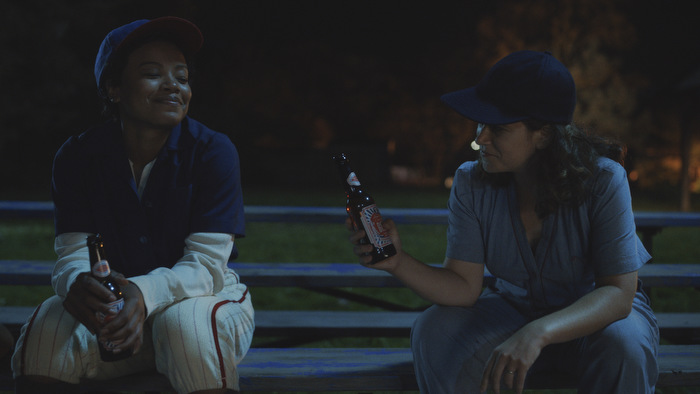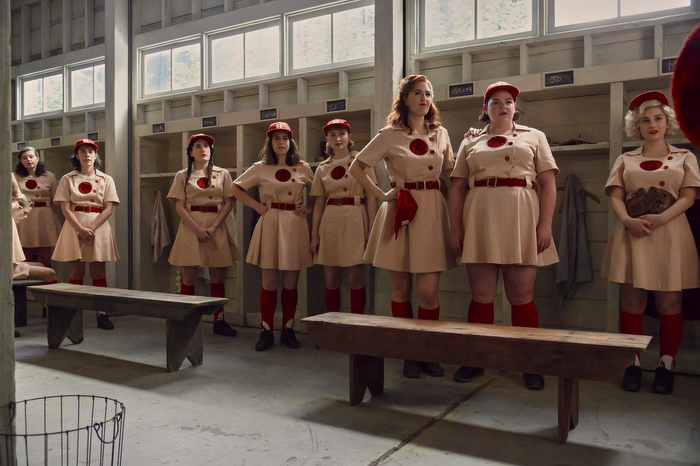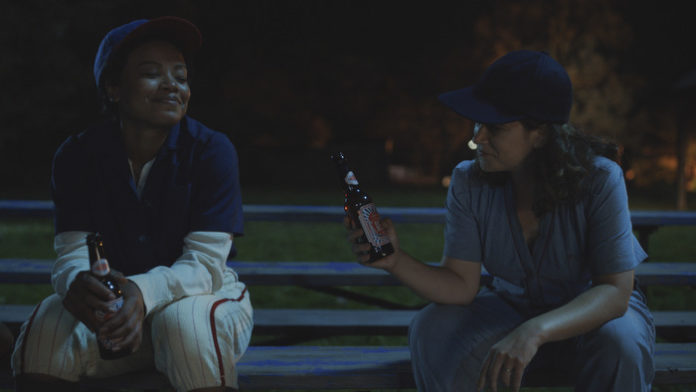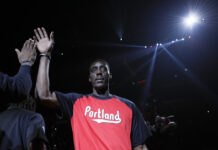Batter up, hear that call, the time has come to watch Amazon’s Prime Video’s A League of Their Own series. The eight-episode TV show, now available to stream in full, offers a new spin on the beloved 1992 Penny Marshall film of the same name that tells the (mostly) true story of the All-American Girls Professional Baseball League (AAGPBL) founded by Philip K. Wrigley, the gum magnate and Chicago Cubs owner, during World War II. The series isn’t a remake of the beloved 30-year-old film starring Geena Davis, Madonna, and Rosie O’Donnell, but a “reimagining,” according to the show’s co-creator and star Abbi Jacobson. “We are really attempting to tell the stories that were missing from the film, and about this league in particular,” she told Entertainment Tonight earlier this month.
The new A League of Their Own, like its predecessor, follows the Rockford Peaches over the course of the league’s 1943 inaugural season. Yet the historical dramedy does so with a more inclusive purview and cast, focusing on two topics the film all but ignores: race and sexuality.
The show stars Jacobson as Carson, the Peaches’ starting catcher, whose acceptance into the league allows her a chance not just to play professional baseball but to broaden her sexual horizons. The series also tells the parallel story of Max, a talented pitcher, played by Chanté Adams, who isn’t allowed to try out for the AAGPBL because she is Black. The rejection puts her on a different path toward becoming a professional ball player and a journey toward redefining her gender identity. Both of these characters offer a modern take on the overlooked and misunderstood women of the AAGPBL, as well as a loving addendum to Marshall’s film. Ultimately, A League of Their Own differs from the movie, but it stays true to history.
Black women were ineligible for the AAGPBL but did play professional baseball
Black women were denied the chance to try out for the AAGPBL because, like Major League Baseball in the early ‘40s, it was informally segregated. (The MLB’s color barrier was broken in 1947 when Jackie Robinson signed with the Brooklyn Dodgers.) The original movie touches on this fact very briefly in a scene in which a Black woman (played by DeLisa Chinn-Tyler) sitting in the segregated area of the ballpark’s stands throws a foul ball back to Rockford Peaches pitcher Ellen Sue (Freddie Simpson) with such force that it stings her hand. “It did bother us that in order to be historically accurate [about the AAGPBL], we could not have a diverse cast,” screenwriter Lowell Ganz told Buzzfeed in 2017. The less than 15-second scene was Ganz and his co-writer Babaloo Mandel’s way of acknowledging the racial injustices of the AAGPBL, which did allow white-passing Latinas to play. Thirty years later, the Amazon series expands upon the memorable moment to show that despite being unable to play for the league, which ran for 12 seasons between 1943 and 1954, there were Black women who played professional baseball. Max is based on the only three women to ever play in the Negro League: Toni Stone, Mamie “Peanut” Johnson, and Connie Morgan.

Chante Adams, left, and Abbi Jacobson in ‘A League of Their Own’
Prime Video
Stone (real name, Marcenia Lyle Alberga) became the first Black woman to play in the Negro League when she was signed by the Indianapolis Clowns in 1953. Lizzie Murphy, known as “the Queen of Baseball,” was the first woman to ever play professional baseball alongside men. In 1922, she played first base for the Boston Red Sox during a charity exhibition game. No woman has ever been signed by MLB in its 146-year history, despite there being no rules against women playing for the league, which makes Stone’s signing an impressive feat. She became her team’s second baseman after they lost a talented infielder named Hank Aaron to the Boston (soon-to-be Milwaukee) Braves. Stone was considered to be the top female player in the 1940s and ‘50s due to her powerful swing. The career .243 hitter would later say the “happiest moment” of her life was getting a hit off legendary pitcher Satchel Paige, considered by many to be the greatest pitcher in Negro League history.
Despite her success, Stone was not welcomed into the league by her fellow ballplayers. She had scars on her wrists from when male players tried to spike her with their cleats while sliding into second base. She told the San Francisco Chronicle in 1991 that her own teammates would tell her to “go home and fix my husband some biscuits.” Stone only played two years in the Negro League, but her impressive play led to her induction into the Women’s Sports Hall of Fame in 1993, three years before her death at the age of 75.
Johnson was the second female player and first female pitcher to join the Negro League after signing with the Indianapolis Clowns months after Stone joined the team. Over the course of Johnson’s three-year career, she recorded 33 wins and eight losses. She also boasted a career batting average of .273. Johnson, who died in 2017, had gone to try out for the AAGPBL with a friend, but both women were turned down because they were Black. She later said that being rejected from the AAGPBL was one of the best things that ever happened to her. “If I would have played with the women, I would have missed out on the opportunity that I received, and I would have just been another player,” she told the Kansas City Star in 2010. “But now, I’ve done something that makes me stand out a little bit.”
It was Stone and Johnson who inspired Morgan to join the Negro League. After five seasons with the North Philadelphia Honey Drippers, an African American women’s baseball team, she wrote Syd Pollock, the Clowns’ general manager, asking for a tryout. He was so impressed by what he saw, he signed Morgan in 1954 to replace Stone (on Stone’s recommendation) at second base. Morgan ended her one-year stint in the Negro League with a career batting average of .300. In 2010, Sports Illustrated went as far as to say that Morgan, who died in 1996, might have been the most talented female player to ever play in the Negro League.
Read More: The Story Behind Netflix’s Late-in-Life Coming-Out Documentary A Secret Love
Queer people and their stories are at the heart of A League of Their Own—and the real league
A League of Their Own has become an iconic queer movie despite having no openly gay characters. (Rosie O’Donnell, who makes a cameo in the series, recently admitted that she has always believed her A League of Their Own character was gay, but Marshall disagreed.) The series looks to change that by putting the lives of queer people front and center. Players in the All-American Girls Professional Baseball League were forced to hide their sexuality in plain sight. This was not only to keep their spots on the team, but so they could protect themselves and their families from the dangers that came with being gay. (Homosexuality was considered a mental disorder by the American Psychiatric Association up until 1973.)
Yet Maybelle Blair, the former AAGPBL player who inspired Madonna’s character in A League of Their Own, recently admitted that “out of 650 [players in the league], I bet you 400 was gay.” The now 95-year-old was one of them. “I think [the show] is a great opportunity for these young girl ball players to come [to] realize that they’re not alone, and you don’t have to hide,” Blair said during a June panel at the 2022 Tribeca Festival. “I hid for 75, 85 years and this is actually basically the first time I’ve ever come out.”

Abbi Jacobson, left, and D’Arcy Carden in ‘A League of Their Own’
Nicola Goode—Prime Video
The AAGPBL looked to erase lesbians from its history and there wasn’t much the players could do to stop it back then. “We were born at a time when we were all in the closet and that was just the name of the game,” Dot Wilkinson, one of the greatest softball players of all time, who is also gay, said in the 2015 documentary Extra Innings. “And you had to live with it and that’s what we did.” Wikinson turned down the opportunity to play in the AAGPBL because she didn’t want to adhere to the league’s strict code of conduct, which forbade players from fraternizing with members of rival teams. One AAGPBL manager reportedly released two players whom he suspected were romantically involved, concerned that they would “contaminate” their teammates, according to The Nation. Others like Terry Donahue, who played for the Peoria Redwings from 1946 through 1949, hid her seven-decade relationship with wife Pat Henschel from the world. Their love story was the subject of the 2020 Netflix documentary A Secret Love.
The new series celebrates the league’s queer history by bringing the lives of these ballplayers out of the shadows. The scene in which Carson discovers a hidden gay bar was inspired by Blair’s own experiences on the road with her teammates, but ends much differently for the fictional character, who learns the hard way the dangers of being gay, even behind closed doors, in the ‘40s. The series says the “things that Penny Marshall couldn’t say in 1992,” Blair, who acted as a consultant for the show, told the Los Angeles Times in August. “People weren’t ready for any of this [back then], but it needed to be told because it is the truth.”
Read More: Amazon’s Well-Meaning Revisionist A League of the Own Falls Short of a Home Run
There’s a charm school scene in the TV series that is more historically accurate than the movie
It’s hard to forget the scene in the movie in which Dottie, Kit, and the rest of the Rockford Peaches are forced to attend charm school. There they’re taught how to walk “gracefully and grandfully,” sit like a lady, and sip tea without slurping, all of which is played for laughs. The show’s charm school scene, however, gets at the real consequences that came with being told you weren’t feminine enough to play baseball when one woman is sent home for not curtseying right and another nearly loses her spot for not applying her makeup correctly.
The motto of the AAGPBL was “play like a man, look like a lady,” and players were required to maintain a rigid beauty and personal hygiene routine to maintain their roster spots. Former players have said that the Helena Rubenstein-run charm school was the AAGPBL’s way of weeding out the women they feared would be perceived as lesbians. Josephine “JoJo” D’Angelo, who identified as gay, claimed she was kicked off her team for having a “butchy haircut.” A former player named Connie Wisniewski was reportedly told “she’d be kicked off her team if she chose to get a close-trimmed cut.”

A League of Their Own
Anne Marie Fox—Prime Video
No “boyish bobs” was just one of the AAGPBL’s rules that was designed to help women “dress, act, and carry themselves as befits the feminine sex,” according to the league’s official handbook. In the first episode of the series, after watching the tryouts, league owner and candymaker Morris Baker (a Wrigley surrogate played by Kevin Dunn) argues that they’ll “need a magician” to make these women appear more ladylike. “Look at their calves,” he gripes. “They’re enormous!” To which his right hand man Marshall (Nat Faxon) assures him he’ll find someone to “teach the women how to be women.”
In the real league, players were forced to wear lipstick on the field because “every woman wants to have an attractive and pleasing mouth.” They were also required “to preserve your nails in a presentable condition and in keeping with the practical needs of your hands in playing ball.” Players faced fines of up to $10 if they wore pants or shorts outside of their living quarters. Three strikes and they would be thrown out of the league. One player was even told to stop wearing girls’ Oxford shoes “because they were excessively masculine-looking,” according to Girls of Summer: In Their Own League.
Most notably, the women were forced to play in skirts no shorter than six inches above the kneecap because Wrigley, the league’s owner, thought it would be more pleasing to the eye. Despite it being far less safe for the players, who suffered horrible bruises nicknamed “strawberries” from sliding. “When I heard about the league’s uniform, I thought that was a joke. No way was I gonna play ball in a dress,” Joyce Hill Westerman, who played for the AAGPBL between 1944 and 1954, told the Chicago Tribune in 2014. “But then when I saw what kind of ball these ladies played, I was so in awe of them that I changed my mind.”
The new A League of Their Own focuses on the pressure women, especially queer women, were under to follow the league’s patriarchal standards of beauty. What the show makes clear is that these women chose to play by the AAGPBL’s rules because they knew it was the only way to make their dreams of playing professional baseball a reality.
More Must-Read Stories From TIME








